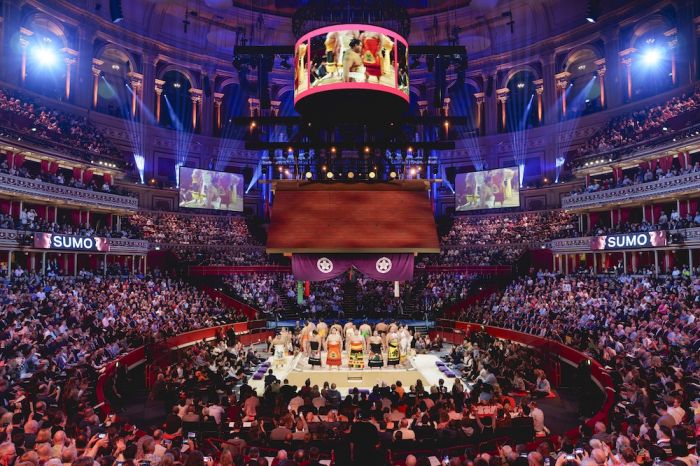London’s most iconic concert hall becomes a temple of Japanese tradition as sumo returns to Britain for the first time in a generation
In the majestic barrel-vault of the Royal Albert Hall, on the fourth evening of the five-day festival of strength and ritual, I found myself immersed in a spectacle that was as much ceremony as combat. The return of the Grand Sumo Tournament to London—the first full basho held outside Japan since 1991—was nothing short of historic. Over five sold-out days, more than forty of Japan’s elite wrestlers transformed one of Britain’s most cherished cultural landmarks into a temple of power, discipline and grace.
An Extraordinary Transformation
The Hall’s familiar grandeur—the scarlet velvet, the curved galleries, the gleaming gilt—had been subtly reimagined. At its centre rose the dohyo: a raised ring of clay and sand built from eleven tonnes of Japanese soil and crowned by a wooden canopy inspired by a Shinto shrine. The effect was transcendent. Beneath the iconic dome, East met West with serene inevitability; the building’s Victorian magnificence proved an unexpectedly perfect vessel for Japan’s most ancient sport.
This was no exhibition or pastiche, but a true hon-basho, presented by the Nihon Sumo Kyokai in partnership with Askonas Holt and the Royal Albert Hall. Only once before—in 1991—had such an event taken place beyond Japan’s borders. The sense of occasion was profound: one could feel history settling into the hush before the first drumbeat.
A Week of Ritual and Rivalry
Across the five days, audiences witnessed a meticulous choreography of ritual, respect and raw power. Each afternoon began with the ceremonial dohyo-iri, as the rikishi—sumo’s elite—entered in magnificent silk kesho-mawashi embroidered with symbols of their stables and regions. The atmosphere was devotional: salt was scattered to purify the ring; wrestlers stamped in rhythmic shiko to repel evil spirits; palms were clapped to summon divine attention.
When combat began, the serenity gave way to seismic energy. The opening tachiai—that thunderous first collision—shook the Hall’s timbers, yet every movement that followed was one of studied control. Sumo is not brute force but balance, precision and intuition honed to a fine edge. Bouts lasted seconds, but within them were entire narratives of dominance and grace.
The Athletes and the Art
Among the competitors were the sport’s leading figures: Yokozuna Onosato Daiki, a rising Japanese prodigy of immense composure; Yokozuna Hoshoryu Tomokatsu of Mongolia, whose explosive speed and poise thrilled the London crowd; and Ozeki Kotozakura Masakatsu, renowned for his impeccable technique. Their presence lent the tournament both prestige and theatre.
Over the course of the week, rivalries unfolded and reputations grew. By the final day, Hoshoryu had triumphed undefeated, securing the Emperor’s Cup and confirming his place among the sport’s modern greats. Yet victory, as in all sumo, was secondary to the display of shin-gi-tai—spirit, technique and body in perfect unity.
The Atmosphere Within
From the stalls, the spectacle was immersive and strangely serene. The audience—an elegant blend of seasoned admirers, cultural connoisseurs and intrigued newcomers—was attentive, reverent, and palpably moved. The applause that followed each bout was not raucous but rhythmic, as though the crowd instinctively understood the etiquette of respect that governs sumo.
The Royal Albert Hall proved the ideal host. Its famed acoustics amplified every sound—the beat of the taiko drum, the slap of flesh, the hiss of shifting sand—transforming each moment into something symphonic. The architecture itself seemed to participate: the dome caught the reverberations, sending them rolling through the gilded tiers like a chant.
Behind the Scenes
The logistics of staging the tournament in London were as intricate as the sport itself. Seating was reinforced to accommodate wrestlers weighing up to 200 kilograms; facilities were discreetly adapted; the imported soil was hand-laid under Japanese supervision. The Hall’s kitchens served up vast quantities of chanko-nabe, the nourishing stew that sustains the athletes. Every detail spoke of collaboration, respect and authenticity.
The wrestlers, too, embraced London with warmth—appearing at schools and cultural events, and greeting admirers with characteristic humility. For many, it was their first visit to the UK; for British audiences, their first close encounter with a living Japanese tradition unchanged in its essence for over a millennium.
A Meeting of Worlds
Sumo’s residency at the Royal Albert Hall felt less like a temporary transplant and more like an act of cultural alignment. Both institutions—Japan’s ancient basho and Britain’s 19th-century concert hall—share a reverence for ritual, form and excellence. Each celebrates performance that transcends language.
When the final yumitori-shiki, the bow-twirling ceremony, closed the tournament, the crowd rose in sustained applause—a gesture of gratitude rather than triumph. As the wrestlers filed out beneath the great dome, there was a lingering sense that something sacred had been shared.
The Grand Sumo Tournament was more than a sporting event; it was a conversation across continents, a moment of mutual reverence. For five unforgettable days, the Royal Albert Hall became a temple not of music, but of motion—a place where faith, grace and human strength were expressed in silence, in rhythm, and in sand.
The Grand Sumo Tournament took place at the Royal Albert Hall from 15-19 October 2025














